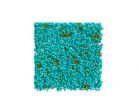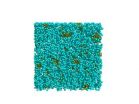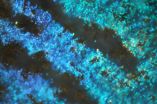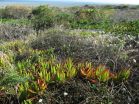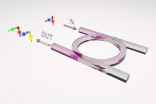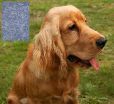(Press-News.org) VIDEO:
Researchers from the University of Pennsylvania and the University of California, Santa Barbara, have now shown how giant clams use iridescent structures to thrive, operating as exceedingly efficient, living greenhouses...
Click here for more information.
Evolution in extreme environments has produced life forms with amazing abilities and traits. Beneath the waves, many creatures sport iridescent structures that rival what materials scientists can make in the laboratory.
A team of researchers from the University of Pennsylvania and the University of California, Santa Barbara, has now shown how giant clams use these structures to thrive, operating as exceedingly efficient, living greenhouses that grow symbiotic algae as a source of food.
This understanding could have implications for alternative energy research, paving the way for new types of solar panels or improved reactors for growing biofuel.
The study was led by Alison Sweeney, assistant professor in the Department of Physics and Astronomy in Penn's School of Arts & Sciences, and Daniel Morse, professor emeritus in UCSB's Department of Molecular, Cellular and Developmental Biology and Director of its Marine Biotechnology Center. The team also includes lead author Amanda Holt, a postdoctoral researcher formerly at UCSB and now at Penn, as well as Sanaz Vahidinia of NASA's Ames Research Center and Yakir Luc Gagnon of Duke University.
It was published in the Journal of the Royal Society Interface.
"Many mollusks, like squid, octopuses, snails and cuttlefish," Sweeney said, "have iridescent structures, but almost all use them for camouflage or for signaling to mates. We knew giant clams weren't doing either of those things, so we wanted to know what they were using them for."
While the true purpose of these iridescent structures, cells known as iridocytes, was not known, the team had a strong hypothesis. Like neighboring coral, giant clams are home to symbiotic algae that grow within their flesh. These algae convert the abundant sunlight of the clams' equatorial home into a source of nutrition but are not particularly efficient in the intense sunlight found on tropical reefs; sunlight at the latitude where these clams live is so intense that it can disrupt the algae's photosynthesis, paradoxically reducing their ability to generate energy.
The team members began their study hypothesizing that the clams' iridocytes were being used to maximize the usefulness of the light that reaches the algae within their bodies. They were first confounded by the relationship between these iridescent structures and the single-celled plants, until they realized that they had an incomplete picture of their geometry. When they made more precise cross sections of the clams, they found that the algae were organized into pillars, with a layer of iridocytes at the top.
"When we saw the complete picture, we understood that the pillars are oriented exactly the wrong way if you want to catch sunlight," Sweeney said. "That's where the iridocytes come into play."
The team relied on Amanda Holt and Sanaz Vahidinia to model exactly what was happening to the light once it passed through the iridocytes; the degree of disorder within these cells bore a resemblance to structures Vahidinia studies at NASA: the dust of Saturn's rings.
Their analysis suggested that the iridocytes would scatter many wavelengths of light in a cone-like distribution pointing deeper into the clam. Red and blue wavelengths, the most useful to the algae, spread the widest, impacting the sides of the pillars in which the single-celled plants were stacked.
To test this model, the team constructed fiber optic probes with spherical tips the size of an individual alga. Threaded through a section of clam flesh alongside the native algae, this spherical probe was able to detect the angled light scattered by the iridocytes, whereas a flat-tipped probe, only able to sense light shining straight down, detected nothing.
"We see that, at any vertical position within the clam tissue, the light comes in at just about the highest rate at which these algae can make use of photons most efficiently," Sweeney said. "The entire system is scaled so the algae absorb light exactly at the rate where they are happiest."
"This provides a gentle, uniform illumination to the vertical pillars consisting of the millions of symbiotic algae that provide nutrients to their animal host by photosynthesis," said Morse. "The combined effect of the deeper penetration of sunlight — reaching more algae that grow densely in the 3-dimensional volume of tissue — and the "step-down" reduction in light intensity — preventing the inhibition of photosynthesis from excessive irradiation — enables the host to support a much larger population of active algae producing food than possible without the reflective cells."
Mimicking the micron-scale structures within the clam's iridocytes and algal pillars could lead to new approaches for boosting the efficiency of photovoltaic cells without having to precisely engineer structures on the nanoscale. Other alternative energy strategies might adopt lessons from the clams in a more direct way: current bioreactors are inefficient because they must constantly stir the algae to keep them exposed to light as they grow and take up more and more space. Adopting the geometry of the iridocytes and algal pillars within the clams would be a way of circumventing that issue.
"The clam has to make every square inch count when it comes to efficiency," Sweeney said. "Likewise, all of our alternatives are very expensive when it comes to surface area, so it makes sense to try to solve that problem the way evolution has."
INFORMATION:
The research was supported by the Army Research Office and the Office of Naval Research.
PHILADELPHIA, PA – Physicians have long speculated at the hard-to-treat nature of joint infection. In an article published in Journal of Infectious Diseases, Thomas Jefferson University scientists, in collaboration with scientists at the National Institutes of Health, come one step closer to understanding why these infections are so tough to tackle. The results could help explain the joint pain caused by different infections, including Lyme disease and why they're so resistant to antibiotic treatment.
"Biofilm formation has been suspected to play a key role during septic ...
New research suggests treatment in Australia and New Zealand for patients with sepsis is the best in the world.
The large-scale six-year study, led by the Australian and New Zealand Intensive Care Research Centre at Monash University, divided 1600 patients into two groups, who were admitted to emergency care with early stage sepsis from across more than 40 hospitals.
The first group of 796 patients received Early Goal Directed Therapy (EGDT), an aggressive treatment not currently used in Australia and New Zealand, which inserts a catheter into the jugular vein to monitor ...
Published today in PLOS ONE, the study is the first in the world to show that it is possible to predict abstract judgments from brain waves, even though people were not conscious of making such judgments.
The study also increases our understanding of impulsive behaviours and how to regulate it.
It found that researchers could predict from participants' brain activity how exciting they found a particular image to be, and whether a particular image made them think more about the future or the present.
This is true even though the brain activity was recorded before ...
PROVIDENCE, R.I. [Brown University] — Dov Sax of Brown University and Jason Fridley of Syracuse University aren't proposing a novel idea to explain species invasiveness. In fact, Charles Darwin articulated it first. What's new about Sax and Fridley's "Evolutionary Imbalance Hypothesis" (EIH) is that they've tested it using quantifiable evidence and report in Global Ecology and Biogeography that the EIH works well.
The EIH idea is this: Species from regions with deep and diverse evolutionary histories are more likely to become successful invaders in regions with less deep, ...
Molecular studies of plants often depend on high-quantity and high-quality DNA extractions. This can be quite difficult in plants, however, due to a diversity of compounds and physical properties found in plants. "Tannins, tough fibrous material, and/or secondary compounds can interfere with DNA isolation," explains Dr. Thomas Givnish, principal investigator of a new study published by Jackson Moeller et al. in the October issue of Applications in Plant Sciences (available for free viewing at http://www.bioone.org/doi/pdf/10.3732/apps.1400048).
This is further complicated ...
WASHINGTON, Oct. 2, 2014—Commercial devices capable of encrypting information in unbreakable codes exist today, thanks to recent quantum optics advances, especially the generation of photon pairs—tiny entangled particles of light. Now, an international team of researchers led by professor Roberto Morandotti of INRS-EMT in Canada, is introducing a new method to achieve a different type of photon pair source that fits into the tiny space of a computer chip.
The team's method, which generates "mixed up" photon pairs from devices that are less than one square millimeter ...
VIDEO:
A new study suggests ibuprofen can make old lungs look young. In lab tests, daily ibuprofen lowered lung inflammation in elderly mice. The research and its implications are described by...
Click here for more information.
COLUMBUS, Ohio – New research shows that the lungs become more inflammatory with age and that ibuprofen can lower that inflammation.
In fact, immune cells from old mouse lungs fought tuberculosis bacteria as effectively as cells from young mice after ...
Grandparents can significantly influence parents' decisions to have additional children and the well-being of grandchildren, according to a recent study completed at the University of Eastern Finland.
In his PhD study, Dr Antti O. Tanskanen observed that grandparents' help with childcare and emotional support are linked to mothers' willingness to have a second or a third child. Furthermore, parents of small children who obtain support from paternal grandparents are also more likely to have additional children. The involvement of maternal grandparents in the lives of their ...
Bethesda, MD (Oct. 2, 2014) — Nonsteroidal anti-inflammatory drugs (NSAIDs) — such as ibuprofen and aspirin — increase one's risk of upper gastrointestinal bleeding. When taken in combination with other drugs, this risk is significantly higher, according to new research appearing in the October issue of Gastroenterology, the official journal of the American Gastroenterological Association.
"These findings may help clinicians tailor therapy to minimize upper gastrointestinal bleeding, and are especially valuable in elderly patients who are likely to use multiple drugs ...
The bond between humans and dogs is strong and ancient. From being the protector of the first herds in a faithful pet, dogs and people share many aspects of life. The relationship between the two species has been studied by psychologists, anthropologists, ethnologists and also by genetic and molecular biologists. In this sense, dogs are a great model for understanding the causes of human diseases, especially cancer.
Unlike other mammals used in research, dogs develop cancer spontaneously as humans do and cancer is the most common cause of death in this species. The dog ...
